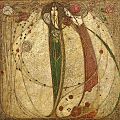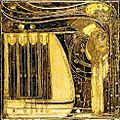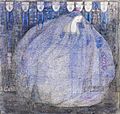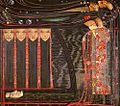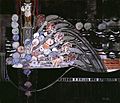Margaret Macdonald Mackintosh facts for kids
Quick facts for kids
Margaret Macdonald Mackintosh
|
|
|---|---|
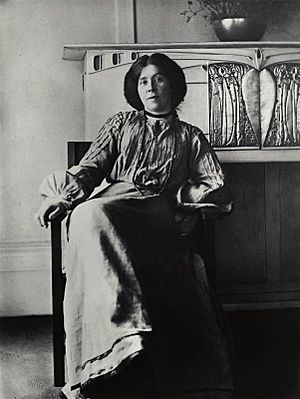 |
|
| Born |
Margaret Macdonald
5 November 1864 |
| Died | 7 January 1933 (aged 68) |
| Nationality | English |
| Education | Glasgow School of Art |
| Known for | Decorative Arts, Design, Art |
| Movement | Art Nouveau, Glasgow Style, Symbolism |
| Spouse(s) | Charles Rennie Mackintosh |
Margaret Macdonald Mackintosh (born November 5, 1864 – died January 7, 1933) was an English artist who lived and worked in Scotland. Her amazing designs helped define the unique "Glasgow Style" of art in the late 1800s and early 1900s.
Contents
About Margaret Macdonald Mackintosh
Margaret Macdonald was born in Tipton, England. Her father was a manager at a coal mine. Margaret and her younger sister, Frances Macdonald, went to Orme Girls' School. In 1890, her family moved to Glasgow, Scotland.
Margaret and Frances both enrolled at the Glasgow School of Art. They studied design there. Margaret worked with many different materials. These included metal, embroidery, and fabrics. She also joined groups like the Scottish Society of Watercolor Painters.
Early Artistic Collaborations
Margaret started working with her sister Frances. In 1896, they opened their own studio in Glasgow. They created many things together. These included book illustrations and embroidered pieces. They also made gesso panels and leaded glass. Gesso is a material like plaster used for decorating. They also did repoussé metalwork. This is a way of shaping metal by hammering it.
Their art was new and exciting. It was inspired by old Celtic stories and symbols. Later, Margaret worked with her husband, Charles Rennie Mackintosh. He was an architect and designer. They married in 1900. Her most famous works are the gesso panels. She made these for buildings Charles designed. These included tearooms and private homes.
Charles Rennie Mackintosh is a very famous Scottish architect. Margaret Macdonald Mackintosh was not always as well-known. However, many people admired her work during her lifetime. Her husband even wrote to her, saying she was "half if not three-quarters in all my architectural work." He also reportedly said, "Margaret has genius, I have only talent."
Margaret's art was shown in over 40 exhibitions. These were in Europe and America between 1895 and 1924. Sadly, poor health stopped her from creating art after 1921. She passed away in 1933. This was just over four years after her husband died.
The Glasgow Four and Teamwork
It is not clear when the Macdonald sisters first met Charles Rennie Mackintosh. They also met his friend and colleague, Herbert MacNair. They probably met around 1892 at the Glasgow School of Art. The headmaster, Francis Newbery, likely introduced them. He saw that they had similar art styles.
By 1894, they were showing their art together. Some of their pieces were made as a team. People had different opinions about their work. Some thought the Macdonald sisters' art looked "ghoulish." This was because of its thin, long shapes. It was influenced by artist Aubrey Beardsley. People even called them "The Spook School." Together, they became known as "The Four."
Working with Her Sister and Husband
Most of Margaret's teamwork in the 1890s was with her sister Frances. This was especially true after they opened their studio in 1896. Some artworks were made by both sisters together. Others were a series of works. For example, they made four paintings with repoussé frames about the seasons. They also created illustrations for William Morris's book, Defence of Guenevere. These were recently found again at the University at Buffalo.
Margaret created several important interior designs with her husband. Many of these were made in the early 1900s. They include the Rose Boudoir at an exhibition in Turin in 1903. They also designed the House for an Art Lover in 1900. Another famous project was the Willow Tea Rooms in 1902.
Margaret and Charles showed their art at the Vienna Secession in 1900. This was an art movement in Vienna. Margaret's work influenced famous artists like Gustav Klimt and Josef Hoffmann. The Mackintoshes remained popular in Vienna. They both showed their art at another exhibition there in 1909.
The Waerndorfer Villa Project
In 1902, the couple received a big project in Vienna. Fritz Waerndorfer was building a new house. He wanted to show the work of many local architects. Josef Hoffmann and Koloman Moser were already designing rooms. Waerndorfer asked the Mackintoshes to design the music room.
Margaret decorated this room with her art panels. These included Opera of the Winds and Opera of the Seas. She also created Seven Princesses. This was a new, large artwork made of three panels. Many people think it is her best work. A writer at the time said this project was "perhaps their greatest work." This was because they had complete freedom to create.
Artistic Inspiration and Style
Margaret Mackintosh did not keep sketchbooks. This shows that she used her imagination a lot. She did not just copy nature. A few things greatly inspired her art. These included the Bible and the Odyssey. She also found ideas in poems by William Morris and Dante Gabriel Rossetti. The works of Maurice Maeterlinck were also important to her.
Her art, and her sister's, was very different from other artists of their time. One writer, Gleeson White, said they had a "delightfully innocent air." He noted they didn't claim any special interest in Egyptian art. They simply said, "We have no basis." They didn't follow any strict art rules.
When she started her art career, she tried many new things. She used her imagination to create new versions of old ideas. For example, she turned big ideas like "Time" and "Summer" into very stylish human shapes. Her designs were truly original. This made her stand out from other artists of her time.
Famous Artworks
Some of Margaret Mackintosh's most famous works are her gesso panels. One is The May Queen. This was made to go with Charles Rennie Mackintosh's panel, The Wassail. Both were for Miss Cranston's Ingram Street Tearooms. Another famous panel is Oh ye, all ye that walk in Willowwood. This was part of the decorations for the Room de Luxe. The Room de Luxe was in the Willow Tearooms. All three of these artworks are now at the Kelvingrove Art Gallery and Museum in Glasgow. The Willow Tearooms building was restored recently. A copy of "Oh ye, all ye that walk in Willowwood" is now back in its original spot.
Her biggest work is the Seven Princesses. These are three large gesso panels. They show a scene from a play by Maurice Maeterlinck with the same name. This artwork was very popular in Vienna. When the Waerndorfer villa was sold in 1916, the artwork disappeared. In 1990, it was found again in a box. It was in the basement of the Museum of Applied Arts in Vienna. Now, it is always on display there.
In 2008, her 1902 artwork The White Rose and the Red Rose was sold at auction. It sold for 1.7 million British pounds, which was about $3.3 million US dollars.
In Fiction
Margaret Macdonald Mackintosh is the narrator in a short story called MMM. It was written by Kirsten MacQuarrie. The story is about the time the Mackintoshes spent in Port Vendres.
Gallery
See also
 In Spanish: Margaret Macdonald para niños
In Spanish: Margaret Macdonald para niños




